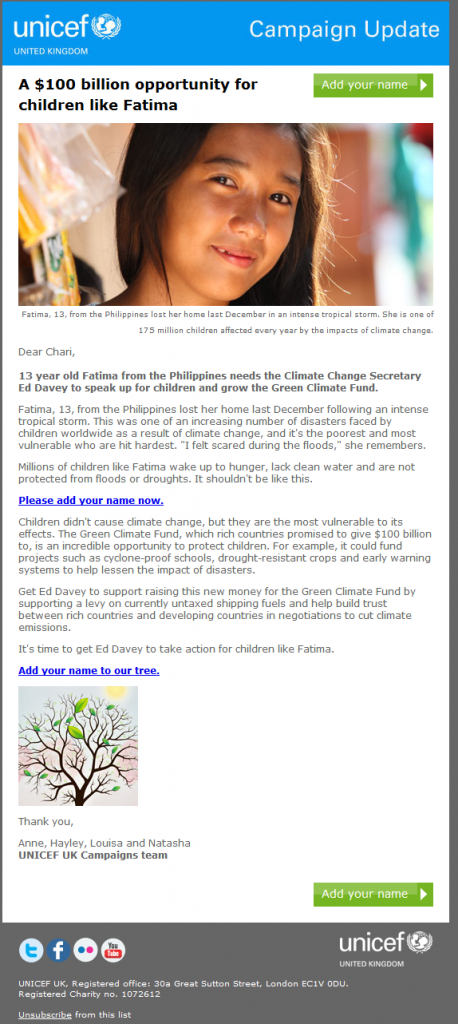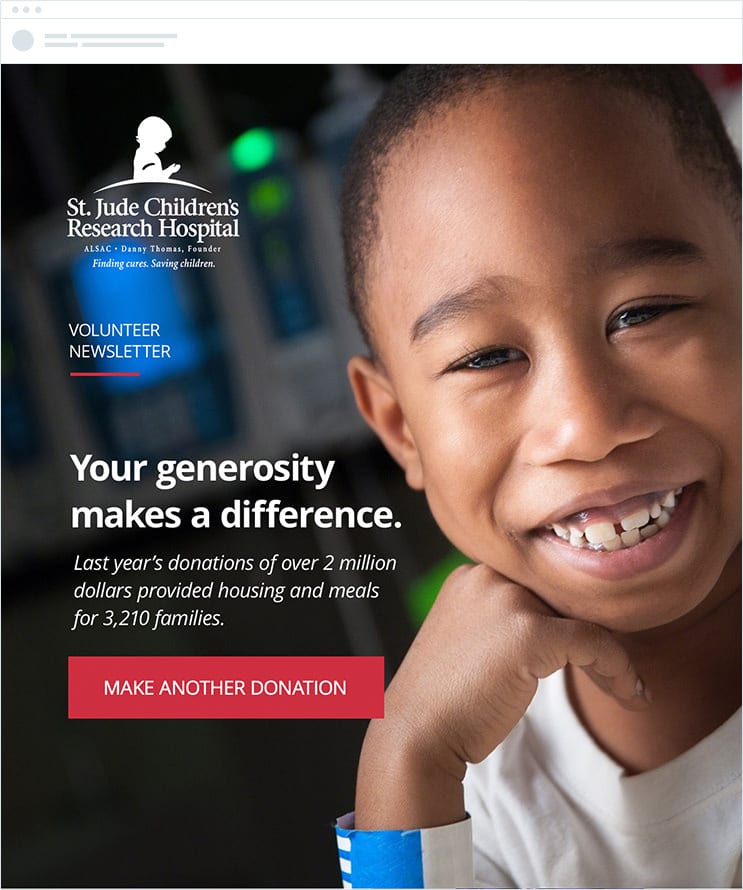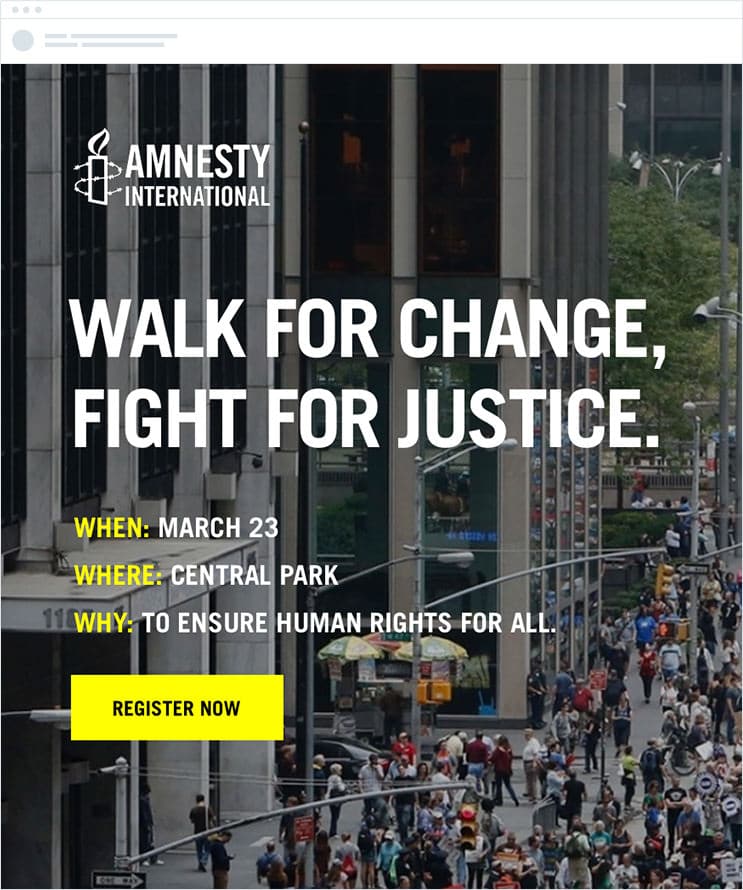This post was originally published November 2015, updated May 2020.
The season for holiday shopping, family feasts, and gift giving: The last few months of the year are a busy time for everyone—especially nonprofits.
While retailers are busy with glitzy sales events featuring the year’s must-have items, nonprofits are also working hard to capitalize on the season of giving.
But whether it’s clutch time for nonprofits, or you’re looking to improve your strategy throughout the course of the year, there are certain methods of fundraising that email can always facilitate. Before getting into those emails, lets cover the basics of donation solication.
How to inspire donations
About 50% of nonprofit organizations receive the majority of their donations between October and December, according to a GuideStar survey. In 2015, the average U.S. donation was $137, with over 698,961 donors and a total of $358.4 billion according to Giving USA.
With so much riding on the last few months of the year, it’s important to use email marketing as a donation vehicle.
How do nonprofits fundraise?
Fundraising opens the door for nonprofits to not only raise money, but also raise awareness. One of the best parts of fundraising is the fact that there are quite literally hundreds of different ways to go about it. A few samples of popular fundraising ideas for nonprofits include:
- Crowdfunding
- Peer-to-peer fundraising
- Walks or races
- Trivia nights or charity auctions
- Online donations
- Email fundraising
- Donation kiosks
How do you solicit donations?
Donors are a critical piece of the puzzle when it comes to nonprofits reaching goals and remaining open. That means that nonprofits must employ marketing tactics to fundraise—but how does one do that without coming off as money-hungry?
The best way to market to donors is to have a clear story and tell it in as many ways as possible. You have a cause that impacts people—so turn that into a story and market it to the your audience.
When we say “make it into a story,” that doesn’t mean make up a story. This is where personal experiences and testimonials play a significant part in the nonprofit fundraising cycle.
Source: Hope Abounds
People are touched by personal testimonials, like this one by Julie. Taking this story and sharing it in your email marketing is a great way to generate new donations as readers can see that their money is going to a worthwhile cause.
How often should nonprofits send emails?
While many marketing teams may want a direct answer as to how often they should be sending out their emails asking for donations, there’s no one right answer. It all comes down to the nonprofit and their audience.
The best way to determine how often you should send out emails is to run A/B tests and monitor key performance indicators to see how often your readers interact with the emails you send. Imagine you begin sending emails once a month and want to increase it to bi-weekly. Try it out for a few months and see what the open and click-through rates look like, as well as your unsubscribe rates. This will give you an idea of how often your readers want to hear from you.
Setting up a preference center is another great way to determine just how often your subscribers want to receive your content.
Nonprofit fundraising emails to help inspire donations
Wether sending in peak #GivingTuesday season or during a big campaign push, there are specific emails that may attract and inspire your audience more than others. Gather ideas from these examples, then test with your own audience to see what they respond to.
1. Gift guide email
During the holiday season, people need a little help in the gift department. To provide inspiration, businesses create gift guides to showcase must-have presents.
Why not try creating a gift guide for your nonprofit? The Red Cross does. Rather than simply asking for a specific monetary donation, this nonprofit and Campaign Monitor customer shows its subscribers what gifts can be bought with those donations.
For example, $25 buys five blankets for a displaced family, or a donation of $100 provides meals for 10 people.
This handy gift guide turns donations into tangible gifts. By showing subscribers what their donation can do, it makes an emotional connection that encourages more subscribers to act.
It’s a great alternative to the standard “please give money this holiday season” email.
Tips for creating a gift guide:
- Set a variety of donation amounts. From $5 to $500, every donation counts so make sure your holiday guide includes amounts that fit every budget.
- Be visual. Show subscribers what “gifts” their donations provide with great images. To help subscribers make a connection, use images of real people whenever possible.
- Include a call to action. Make sure the gift guide provides a clear call to action that directs subscribers to a shopping or donation page.
- Include a shareable link. Ask your subscribers to share the gift guide with others by including a link that allows them to share it.
2. Story email
There’s power in storytelling. If your organization helps those in need, share stories with subscribers to help them understand how important their donation is.
Sure, you could explain that a $10 donation feeds a homeless person for one night, but you can go further than a simple explanation. Don’t just tell donors how their gifts help—show them.
Ask a few people that your organization helps to share their story. You’ll be surprised at the number of people who are willing to share their story as a way to thank your organization for the services provided.
Once you have a few willing volunteers, interview each person, learn about his or her situation and tell their story to your subscribers.
You can create a short article and include it along with a call to action to donate in an email. Here’s an example from UNICEF:

In this example, the brief story of a thirteen-year-old girl, Fatima, helps describe the need for people to act. In this case, UNICEF is asking subscribers to sign a petition.
Storytelling tips:
- Tell a story, not a promotion. The story should focus on a person, not how your organization saved the day. Mention how you help, but make sure the story is fueled by the details and emotion of the person in need.
- Include a picture. Make sure you share a picture of the person; it brings the story to life.
- Make a connection to the holiday season. After telling the story, mention your need for holiday donations (if you’re sending during the holidays). Or if you can tell a story about someone in need during the holidays that’s even better.
- Consider including a video. Creating a video has never been easier. Consider telling a story through video and sharing a link to it via email and on your social sites.
Use an email template for quick, professional sends.
Having a well-designed email can make or break a donor’s conversion. Try out Campaign Monitor’s donation template to make your fundraising email count.
3. Refresher email
The holiday season is a good time to remind donors what your organization is all about.
Create an email that outlines your organization’s mission and the good it does. Consider adding a bulleted list that outlines the number of people helped, and next year’s goals. Or, create a short video that looks back at this year’s accomplishments, explains new initiatives for the year to come or reminds donors about the year-round need.
Check out this example from St. Jude:

The purpose of this email is to inform and solicit donations. Remember, you need to send a diverse variety of emails (even during the holiday season). If you send too many “please donate” emails, you may burn out some donors. Remember, they may be, and probably are, getting many requests for donations this time of year.
A refresher email is the type of email that builds trusts between you and your donors while offering a crash course in why your organization is worth donating to.
Tips to create a refresher email:
- Keep it short. Everyone is busy, but even more so during the holiday season, so keep it brief.
- Consider creating a video. Emails with video have a 53% higher click to open rate than those without. It’s worth taking a little time to create a short (1-2 minute) video this season.
- Help donors learn more. Provide links to your website and social channels in the email to help donors continue their learning process.
4. Event email
A lot of nonprofits host holiday events. Whether you’re hosting your annual gala, coat drive, food collection, or charity auction, use email to invite guests.
Be sure to explain what the event is and tell donors what to expect. Encourage guests to come by explaining what’s in it for them.
Once you send out your initial email, you can use marketing automation to send reminder emails as the event gets closer.
Tips to create and send an event email:
- Double check the details. Run through your email and make sure all of the information is correct. You don’t want to send an invitation with the wrong date or address.
- Offer perks to those who RSVP early. Give early bird RSVPers something special like a free t-shirt, a chance to win a giveaway or a VIP tour of your facility.
- Create an event on Facebook. To cross-promote your event, create a Facebook event and let people RSVP. Facebook explains how to set up an event in five easy steps.
- Provide additional information in reminder emails. When you remind people about your event via email, offer additional information like parking suggestions or a list of speakers featured at the event.
5. Thank you email
When a donation is made, you should follow up with a thank you. It’s important to show gratitude to donors, no matter how big or small a donation is.
The Red Cross takes the thank you email one step further by explaining exactly where the donation went.
The email thanks the donor for his donation of blood and explains that the donation is headed to a specific hospital. It also encourages the donor to share his good deed on social media. It even uses a specific hashtag, #RedCrossOnTheWay, that the donor can use.
This follow-up email accomplishes a lot. It says thanks, follows up on the donation and encourages the subscriber to share some social love on Facebook and Twitter.
Tips to create and send a thank you email:
- Say thanks. A simple message of gratitude should be the first item in the email.
- Reinforce the decision. Remind the subscriber why their decision to donate to your organization was a great one.
- Cross-promote. The Red Cross uses a thank you email to promote a social campaign. It’s a great example of cross-promotion—one that could drum up more support during the holidays.
6. Bonus: a personal email
Another excellent example of a nonprofit email fundraising example is the personal email. The personal email does more than just address the reader directly. It can either provide a personal story that’ll resonate with the reader or it can be a one-on-one style email from someone higher up in the company.
Take this example by Politician Bernie Sanders:
In this email, which clearly is written by Bernie’s marketing staff, the person speaking to the reader (AKA “Bernie”) is giving the reader directions to take action and doing it as if they’re having a one-on-one conversation. This gives the reader incentive to participate.
Another example of a personal email is telling a story of someone whose life will be impacted by giving to your nonprofit. This example by charity : water does an excellent job of sharing a personal story to readers in order to encourage donations.
Source: Really Good Emails
In this email, we meet Srey from Cambodia. She’s from a village that doesn’t have quality water to help them survive day to day. This email tells readers that, with their donation, they’re providing Srey with the necessary means to get that clean water to help her and her village survive.
Tips for creating a personal email to potential donors:
- Tell a real story. Tell a story about someone or something impacted by the donation of the reader. This makes the mission tangible,
- Get detailed. Spare no detail with how the donation is going to help.
- Provide perspective. Addressing the reader from the point of view of someone higher up in the nonprofit makes the reader feel as if they’re important enough to the organization that the leader needs to reach out to them.
Wrap up
As your peak fundraising season approaches, you don’t have to scramble to find email inspiration for your next donation drive—it’s all right here for you. Use these five examples to create effective emails that collect the donations your nonprofit needs to succeed.
Looking for a more comprehensive guide on email marketing for nonprofits? Check out our Ultimate Guide to Email Marketing for Nonprofits today.












